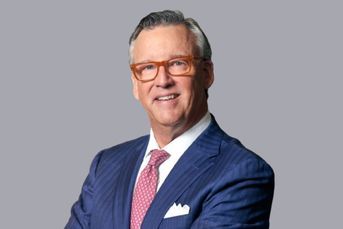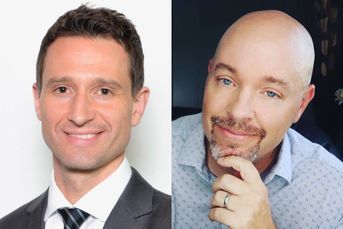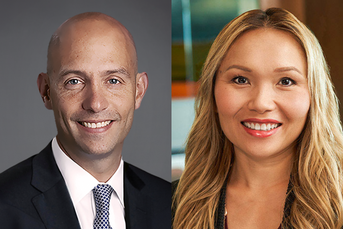‘Magic number’ of $1.5M for retirement? Advisors say no
 Carol Fabbri of Fair Advisors and Juan Hernandez Ariano of WealthCreate Financial
Carol Fabbri of Fair Advisors and Juan Hernandez Ariano of WealthCreate Financial
Setting goals as a percentage of income is smarter, as a big-figure target may not be reliable and can discourage people, advisors said.
A recent report that the “magic number” for retirement savings is nearly $1.5 million was certainly enough to turn heads – but some advisors say such numbers are misleading at best.
According to the results of a January survey of more than 4,500 people that was published this week by Northwestern Mutual, the average amount that people across age groups said they would need to retire comfortably is $1.46 million. That figure was higher for young workers, with Gen Zers and millennials putting their estimates at averages of $1.63 million and $1.65 million, respectively, and Gen Xers saying $1.56 million would do the trick. Meanwhile, baby boomers cited a lower average figure, at $990,000.
The survey found, though, that many boomers and Xers weren’t really confident about how much money they will need, with health care expenses and tax planning also gray areas.
And like numerous other reports, the survey showed that the amount people actually have saved is generally far less than they say they will need, with average retirement assets for boomers being $120,000.
But having a dollar-figure goal can do more harm than good, several advisors told InvestmentNews via email.
“These surveys are not helpful. Everyone’s spending in retirement will be different,” said Daniel Lash, partner at VLP Financial Advisors. “By putting a number to it, this can lead to some to think they have enough, when they don’t relative to their spending, and others to feel like they will never be able to retire because this amount to save seems too daunting.”
What determines a successful retirement is financial planning rather than a magic number, he said.
“Having a huge target number looming ahead of you is threatening and feels impossible to attain – like an enormous weight loss goal,” said Carol Fabbri, principal at Fair Advisors. “Having an annual or monthly savings target is very helpful because it isn’t so intimidating and you can fit it into a budget, so savings becomes a habit, like brushing your teeth.”
Putting a single figure out there, one that will be higher than most people might reach but still too low for some, is a misleading approach that could set people up for failure, said Juan Hernandez Ariano, director at WealthCreate Financial.
“I met with a client in rural upstate New York who only needs $1 million because of a lower-expenditure lifestyle, additional partial retirement income, and retirement expectations,” Hernandez Ariano said. “On the other hand, during my last meeting with a client yesterday, I had a challenging conversation with a client who was projected to have $3.5 million in retirement, and the model showed them running out of money 18 years later.”
How much a person or couple should have saved for retirement is unique to them, said Randy Bruns, founder of Model Wealth.
“We’ve had a couple with $5 million feel less than prepared because they were comparing themselves to their peers,” Bruns said. “In reality, the combination of his Social Security and her teacher’s pension more than provided for their retirement lifestyle. Only in retirement did they realize his worries were unfounded.”
What people should keep in mind – even if they have a dollar-figure for retirement assets in mind – is that they don’t actually have to save that amount, given that investment returns do a lot of heavy lifting, said Ashley Rittershaus, founder of Curious Crow Financial Planning.
“It’s also important to realize that the dollar amount you need for retirement is not set in stone,” Rittershaus said. “If you’re able to find ways to decrease your living expenses, preferably in areas you don’t value, this will have a double benefit when it comes to retirement savings.”
Although having a comparator figure can help people benchmark their savings, it can discourage some, and it can be particularly disheartening for those with traditional pensions, as they may not grasp the lifetime values their plans generate, said Scott Keegan, chief operating officer at Gertsema Wealth Advisors.
A better strategy than targeting a single figure for retirement savings is to set a goal for long-term investing as a percentage of current income, said Ralph Bender, CEO of Enduring Wealth Advisors.
“The premise that there is an overarching asset number for everyone is inane,” Bender said. “Sure, there are people for whom $1.46 million is a good number, but without considering a multitude of variables, including the simple definition of a ‘comfortable’ retirement, it’s impossible to determine the amount an individual household should target for its retirement nest egg.”
Still, having a number in mind – at least as a minimum – can be a motivator.
“Most of my clients are breadwinner women in urban areas – and I do tell them I’d like them to have saved over $2 million in assets (not including home equity) to really enjoy their retirement,” said Catherine Valega, wealth consultant at Green Bee Advisory. “But anything that gets people focused on retirement savings is good – just start working toward getting money into your 401(k), increasing your deferral percentage, paying yourself first instead of last, etc.”
‘Magnificent 7’ slowdown creating opportunities for stock pickers, Stance fund manager says
Learn more about reprints and licensing for this article.








